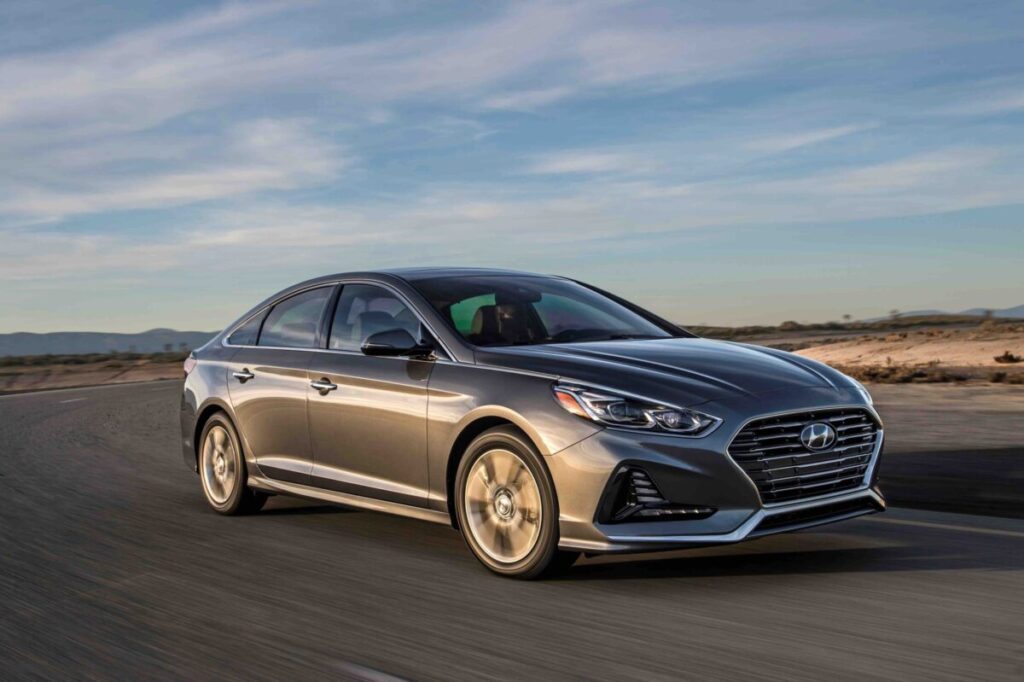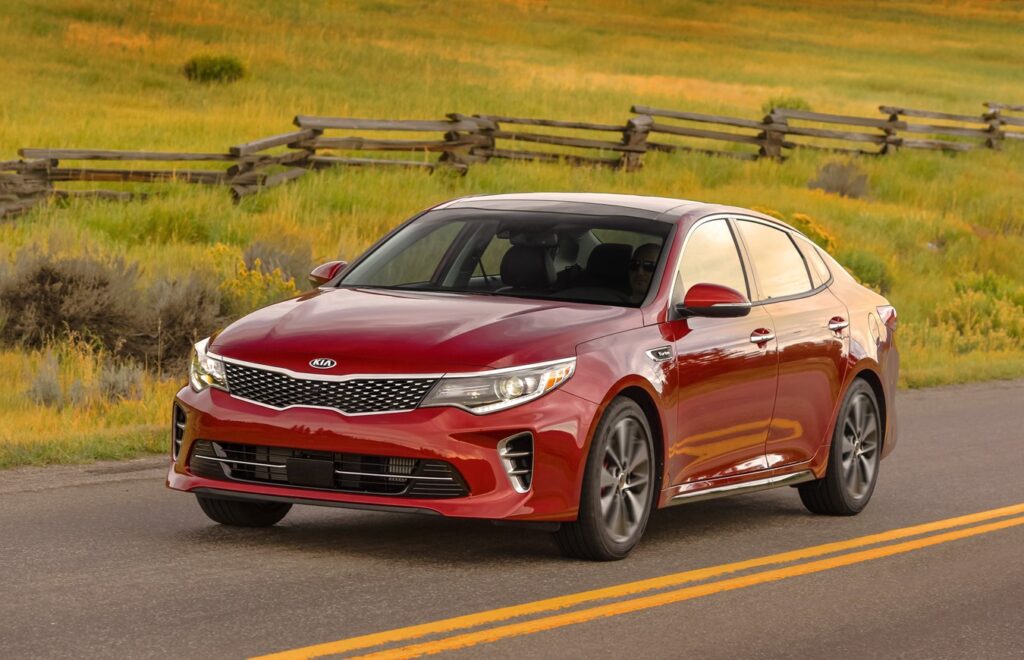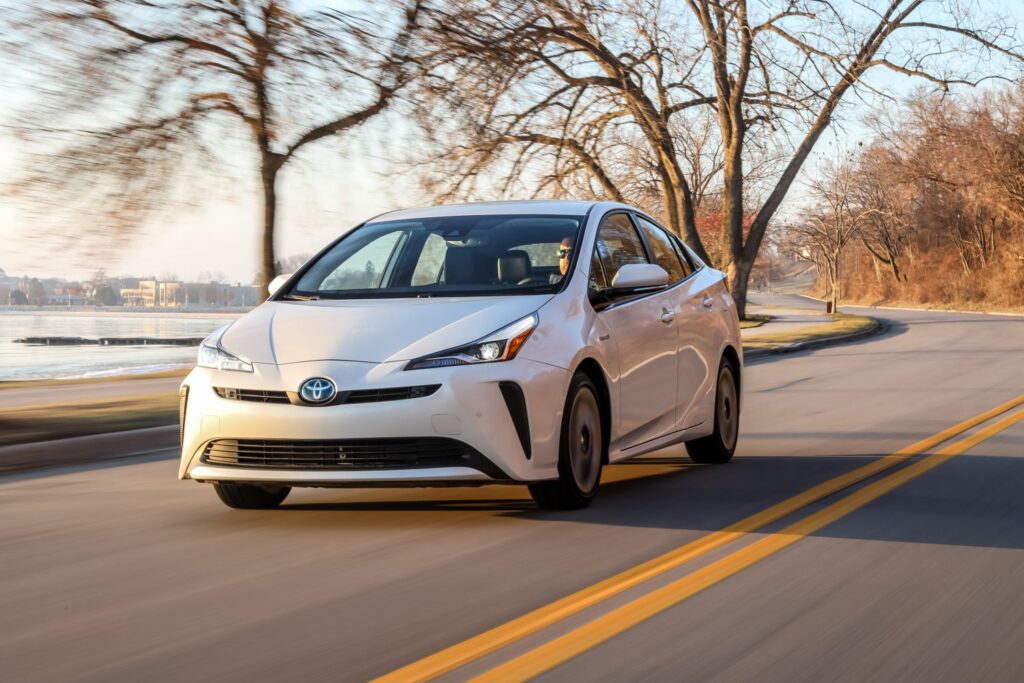The 8 Best Cars for Teenage Drivers

Contents
- Introduction
- How We Made Our Selections
- The Winners
- Honda Accord (2016-2021)
- Honda Civic (2019-2021)
- Hyundai Sonata (2016-2020)
- Kia Optima (2016-2020)
- Mazda 3 (2016-2018)
- Mazda 6 (2016-2021)
- Subaru Legacy (2016-2019)
- Toyota Prius (2016-2019)
- Cars that Didn’t Make the Cut
- Nissan Altima
- Toyota Camry and Toyota Corolla
- Subaru Impreza and Subaru Crosstrek
- The Bottom Line
Introduction
Navigating the used car market can be tricky, especially when you’re looking for a vehicle suitable for a teenager. The stakes are high: You want something safe and reliable but also budget-friendly.
We understand the unique challenges and considerations that come into play when shopping for a teen driver. To simplify your life, we’ve done the heavy lifting and sifted through countless models to bring you a well-rounded list.
Here, we’ll examine cars that check all the boxes, boasting superior safety ratings, commendable reliability, good fuel economy, and a track record of keeping their owners happy over the long haul.
How We Made Our Selections
Below each model, you’ll find a tally of its performance in four key categories: safety, reliability, fuel economy, and owner satisfaction. These are the most critical factors in picking a car suitable for a teenage driver. Of these, we prioritized safety first. As new drivers, teens need all the protection they can get — not just airbags and stability control but also advanced features such as automatic emergency braking, which can prevent an accident from even taking place.
We also limited our selections to the 2016-2021 model years. These are new enough to offer advanced safety features but old enough to have a clear picture of reliability. They also benefit from at least three years of depreciation, helping to keep the price down. We excluded luxury vehicles, too, to help ensure affordability, both in terms of sticker price and ongoing maintenance and repair costs.
To qualify for our list, each model had to meet the following requirements for each recommended year:
- Safety: a five-star overall safety rating from the National Highway Traffic Safety Administration (NHTSA)
- Quality & Reliability: an average Quality & Reliability score of 80 or higher (“Great”) from J.D. Power’s annual Dependability study
- Fuel Economy: a combined fuel economy rating of at least 25 mpg, per the Environmental Protection Agency (EPA)
- Owner Satisfaction: an average overall rating of at least four stars from consumer reviews on Edmunds
Here are the eight cars that made the cut, presented in alphabetical order.
The Winners

Honda Accord (2016-2021)
- NHTSA safety rating: 5 stars
- J.D. Power reliability score: 80
- EPA fuel economy (combined): 26-48 mpg
- Edmunds consumer rating: 4.2 stars
It’s no surprise to find the Honda Accord on our list. The perennial Car and Driver 10Best winner has long been one of the best midsize sedans money can buy. And if you stick to the lower trim levels, buying one doesn’t take a whole lot of coin.
Most Accords come with a four-cylinder engine mated to a continuously variable automatic transmission (CVT). Both a V6 and a six-speed manual are also available, but unless your teen is a budding F1 star, you can probably stick with the four-popper and the CVT. A better upgrade would be to the hybrid version, which re-joined the lineup in 2017 and provides an EPA-rated 48 mpg in mixed driving. In all versions, power routes to the front wheels (only).
Honda revamped the Accord in 2018, making it larger, more powerful, and better equipped. That was the first year the model received the Honda Sensing suite of active safety tech as standard equipment, including automatic emergency braking, lane-keeping assist, and adaptive cruise control. Higher trims offer blind-spot monitoring and parking sensors. Both Apple CarPlay and Android Auto have been standard on all Accord trims since 2016.
Note that the Accord’s reliability scores from J.D. Power dipped slightly with the introduction of its 10th generation in 2018, but not enough to keep it off our list.

Honda Civic (2019-2021)
- NHTSA safety rating: 5 stars
- J.D. Power reliability score: 81
- EPA fuel economy (combined): 29-33 mpg
- Edmunds consumer rating: 4.5 stars
The Honda Civic is a staple of the compact car segment, and for good reason. It’s practical, reliable, and holds its value well. It’s versatile, too, offering a range of body styles from sedan to hatchback to coupe. It also has two notable performance variants, the sporty Si and the track-ready R. However, we recommend that teen drivers stick to the more pedestrian models to quell any racing driver urges.
The 2019-2021 Civic features a standard 2.0-liter four-cylinder engine, with an optional turbocharged 1.5-liter unit for those seeking a bit more grunt. Both mills provide a good mix of efficiency and performance. A continuously variable automatic transmission (CVT) is standard, but a six-speed manual is available for three-pedal enthusiasts. All Civics are front-wheel drive.
Honda gave the 10th-generation Civic a significant update in 2019. One of the important changes was making the formerly optional Honda Sensing suite of safety features standard across all trim levels. That added automatic emergency braking, lane keeping assist, and adaptive cruise control as included driver aids on all models. Apple CarPlay and Android Auto integration is also standard.
Though Honda enjoys a longstanding reputation for quality, Civic models before 2019 received lackluster reliability scores from J.D. Power. That’s why we’ve left those model years off our list.

Hyundai Sonata (2016-2020)
- NHTSA safety rating: 5 stars
- J.D. Power reliability score: 84
- EPA fuel economy (combined): 26-52 mpg
- Edmunds consumer rating: 4.2 stars
The Hyundai Sonata consistently punches above its weight class. The midsize sedan’s generous list of standard features often bests what you find in pricier competitors. And it’s not just about bang for your buck; the Sonata also provides a comfortable ride and a quiet cabin.
Most Sonatas feature a naturally aspirated four-cylinder engine paired with a traditional automatic transmission, providing adequate thrust for daily driving. A turbocharged engine is available for those who crave a bit more zip, but the standard setup should suit most teen drivers just fine. It also comes in a hybrid variant, delivering as much as 52 mpg in mixed driving. Power is sent to the front wheels in all configurations.
In 2018, Hyundai gave the Sonata a significant refresh, focusing on interior upgrades and improved tech. This is the year when blind-spot monitoring and rear cross-traffic alert became standard features, adding an extra layer of safety. In 2020, a full redesign introduced not only a more stylish exterior and cabin but also standard automatic emergency braking, lane-centering assist, and adaptive cruise control. Android Auto and Apple CarPlay have been included since the 2015 model year.
Note that we excluded the 2021 model year from our list because its overall Edmunds consumer rating dropped to 3.8 stars. Scanning the reviews, it seems that owners have had some significant electrical issues beginning with that year. We’d stick to earlier models to avoid this.

Kia Optima (2016-2020)
- NHTSA safety rating: 5 stars
- J.D. Power reliability score: 84
- EPA fuel economy (combined): 25-42 mpg
- Edmunds consumer rating: 4.3 stars
The Kia Optima is another midsize sedan that often flies under the radar but is worth a closer look. Like its South Korean stablemate, the Hyundai Sonata (with which it shares a platform), the Optima competes admirably with more established rivals, offering a compelling mix of practicality and performance for the price.
Most Optimas come with a four-cylinder engine and a six-speed automatic transmission, serving up sufficient power for daily commutes while returning solid, if not class-leading, fuel economy. A turbocharged variant is available for more oomph, but the standard setup will likely keep most folks happy. The Optima is also available as a hybrid, rated at 42 mpg (combined). Front-wheel drive is the only available setup across all versions.
Kia gave the Optima a complete makeover in 2016, transforming it inside and out into one of the most attractive options in the segment. This redesign also introduced several advanced safety features, such as adaptive cruise control and a surround-view camera. However, most remained optional until the 2019 model year, when all Optimas gained a standard suite of driver aids that includes lane-keeping assist and automatic emergency braking. If Android Auto and Apple CarPlay integration is a must-have, know it became standard from the 2018 model year onward.
Kia discontinued the Optima after the 2020 model year, replacing it with the K5. For a full history of the model, see our related article: Kia Optima: Model History and Generations.

Mazda 3 (2016-2018)
- NHTSA safety rating: 5 stars
- J.D. Power reliability score: 82
- EPA fuel economy (combined): 28-32 mpg
- Edmunds consumer rating: 4.5 stars
The Mazda 3 is a compact car that delivers practicality with a sporty touch. Offered in both sedan and hatchback body styles, the zippy little Mazda is also often cheaper on the used car market than its two main rivals, the Honda Civic and the Toyota Corolla (which, notably, failed to make our list — see below for details).
Under the hood, most Mazda 3s come equipped with a 2.0-liter four-cylinder mated to a six-speed automatic transmission. This powertrain strikes a good balance between pep and efficiency, which should keep both parents and teens happy. For a little more involvement, a punchier 2.5-liter engine is available, as is a manual gearbox. All versions send power to the front wheels (only).
While the Mazda 3 gets top marks in safety from NHTSA, it offers fewer active safety features than most other models here. Basics like stability control, a rearview camera, and front and side curtain airbags are included. But upgrades such as blind-spot monitoring, lane departure warning, and automatic emergency braking are mostly limited to higher trims and optional packages. That shifted in 2018 when automatic emergency braking became standard and adaptive cruise control debuted as an option on the top-level Grand Touring trim.
Mazda completely revamped 3 with the debut of the fourth generation in 2019. Those cars boast many new and desirable features, including Apple CarPlay and Android Auto integration; however, they failed to make our list because their reliability scores from J.D. Power dropped below 80. We recommend sticking with the third generation instead.

Mazda 6 (2016-2021)
- NHTSA safety rating: 5 stars
- J.D. Power reliability score: 82
- EPA fuel economy (combined): 26-32 mpg
- Edmunds consumer rating: 4.5 stars
The Mazda 6 is another standout from the Japanese automaker. It blends practicality with a dash of athleticism, making it a charming alternative to more utilitarian choices like the Toyota Camry (which also failed to make the cut — see below). The midsize Mazda’s fluid design and upscale interior also help it stand out in a crowded segment.
Most Mazda 6 examples employ a 2.5-liter four-cylinder engine mated to a six-speed automatic transmission, offering a balanced mix of performance and efficiency. A six-speed manual is also available for fans of rowing your own gears. Those who crave more power may want to hold out for the turbocharged version, which became available starting in the 2018 model year. Front-wheel drive is the standard and only drivetrain.
Mazda gave the 6 a significant refresh in 2018, enhancing its interior quality and making its optional i-ActivSense suite of safety features available at all trim levels. The bundle includes automatic emergency braking, lane departure warning and mitigation, and adaptive cruise control. Earlier model years also offer many of these features, but not only are they optional they are also limited to the higher trim levels. Apple CarPlay and Android Auto integration was also introduced as standard tech with the 2018 update.
After the 2021 model year, Mazda discontinued the 6 without a replacement. That’s too bad. Judging by its remarkable 4.5-star overall rating by owners on Edmunds, it’s clearly a beloved model.

Subaru Legacy (2016-2019)
- NHTSA safety rating: 5 stars
- J.D. Power reliability score: 80
- EPA fuel economy (combined): 23-29 mpg
- Edmunds consumer rating: 4.3 stars
The Subaru Legacy is something of an outlier among midsize sedans, and in a good way. Most in the segment offer front-wheel drive only, but the Legacy comes with all-wheel drive (AWD) standard across all trim levels. That’s a big selling point for anyone who faces challenging weather conditions on a regular basis.
The base Legacy features a 2.5-liter four-cylinder engine coupled with a continuously variable automatic transmission (CVT), offering a smooth but not particularly sporty ride. For a bit more kick, a more powerful 3.6-liter six-cylinder is an option, but it takes a toll on fuel efficiency, knocking it down from 29 to 23 mpg (combined), according to the EPA.
Subaru’s well-regarded EyeSight suite of driver aids has long been an option on the Legacy. It bundles several desirable safety features, including blind-spot monitoring, lane departure warning and intervention, emergency automatic braking, and adaptive cruise control. A mid-cycle refresh in 2018 added Apple CarPlay and Android Auto integration and a host of other upgrades, such as refreshed front and rear styling and a quieter cabin with improved materials quality.
It’s worth mentioning that the Legacy received a complete redesign in 2020, introducing the seventh generation. However, we’re sticking with the 2016-2019 model years for this list, as they offer a better track record for reliability, according to J.D. Power.

Toyota Prius (2016-2019)
- NHTSA safety rating: 5 stars
- J.D. Power reliability score: 85
- EPA fuel economy (combined): 52 mpg
- Edmunds consumer rating: 4.7 stars
The Toyota Prius has long been the poster child for eco-conscious driving, but it’s also a smart choice for teenage drivers. The compact hatchback combines legendary Toyota reliability with exceptional fuel economy. It’s also beloved by owners, achieving a 4.7-star overall rating on Edmunds consumer reviews for the 2016-2019 model years, the highest of any car on our list.
The Prius is powered by a 1.8-liter four-cylinder engine paired with two electric motors and a continuously variable automatic transmission (CVT). It’s not a powerful setup, but it’s adequate for most city and highway driving. Front-wheel drive is standard, but unlike most other cars in the segment, all-wheel drive (AWD) became an option starting in 2019.
Starting with the 2017 model year, Toyota made its previously optional suite of active safety features standard across all Prius trims. It includes automatic emergency braking, lane departure warning and mitigation, and adaptive cruise control. Additional driver aids, including blind-spot monitoring and parking sensors, are available on higher trims.
The Prius was slow to add Apple CarPlay and Android Auto, however. They only became available with the introduction of a new infotainment system for the 2020 model year. This coincides with a notable (and possibly related) drop in the model’s reliability scores from J.D. Power, which is why we’ve limited our recommended years to 2016-2019 only.
Cars that Didn’t Make the Cut
A few popular models are conspicuously missing from our selections. We thought you might want to know why.
Nissan Altima
The Altima gets excellent marks for safety and reliability and returns around 30 mpg (combined). However, the midsize Nissan fails to satisfy owners, averaging a lackluster 3.7 stars overall on Edmunds consumer reviews for the 2016-2019 model years. The following two years (2020-2021) show some improvement, just ticking over our four-star threshold. Stick to these later models if you’re dead set on an Altima.
Toyota Camry and Toyota Corolla
Looking for either of Toyota’s top-selling sedans? You may be just as surprised as we are that they didn’t make the cut. Like the Altima, the Camry and the Corolla easily exceed our bar for safety, reliability, and fuel economy. But owners don’t seem to care for them very much, giving them both just 3.7 stars overall on Edmunds consumer reviews for the 2016-2021 model years.
Subaru Impreza and Subaru Crosstrek
Both the Impreza and its outdoorsy sibling, the Crosstrek, have a lot going for them, including high safety ratings, solid fuel economy, and standard all-wheel drive. However, reliability for the compact Subies is a mixed bag. They muster only average reliability scores from J.D. Power (76 and 77, respectively), short of our threshold.

The Bottom Line
When choosing a used car for your teenager, safety, reliability, and cost-effectiveness are likely at the top of your list. The cars we’ve highlighted here check all those boxes and then some. Whether you’re eyeing a fuel-efficient hybrid like the Toyota Prius, an all-weather winner like the Subaru Legacy, or a sporty yet practical hatchback like the Mazda 3, you’ve got options beyond the usual suspects.
Remember, buying a used car isn’t just about the initial price tag; it’s about the total cost of ownership, which includes insurance, fuel, and maintenance. Most of the cars on our list are known for their durability and relatively low upkeep, ensuring that your teen can focus on what’s important: becoming a responsible and skilled driver.
Photos courtesy of Honda, Hyundai, Kia, Mazda, Subaru, and Toyota